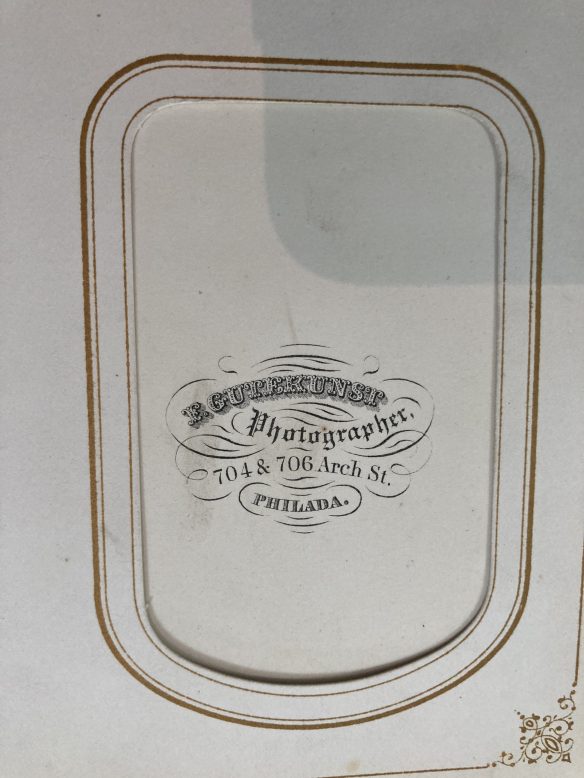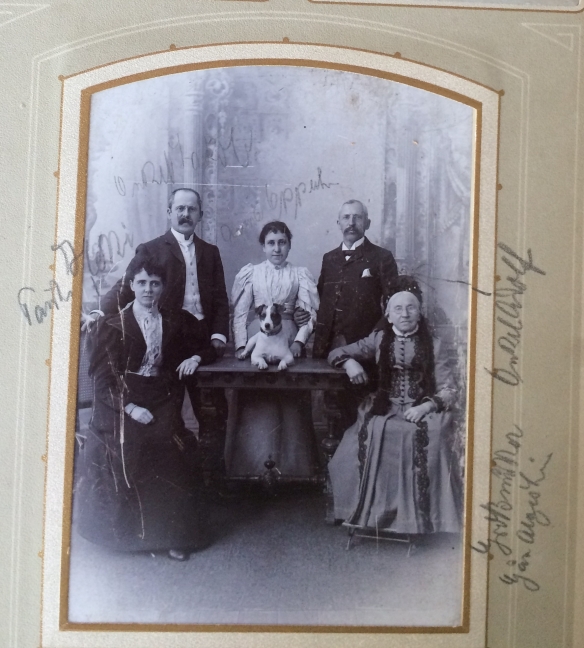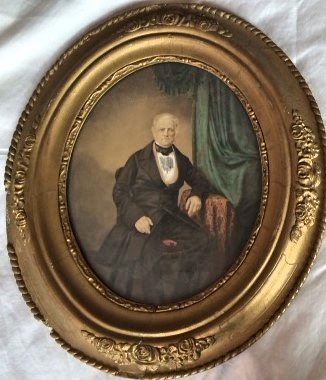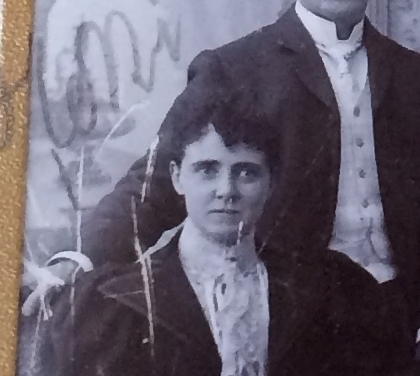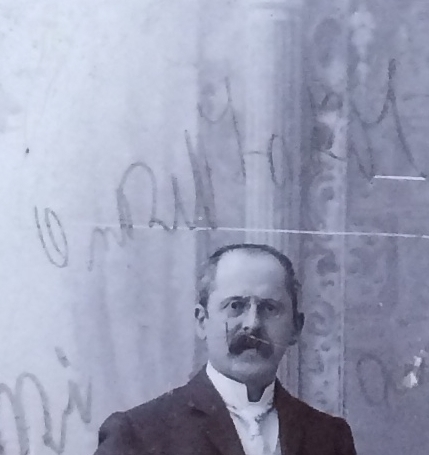Having experienced some disappointment with the first batch of Philadelphia photographs from the Nusbaum album, I brainstormed with Ava about how to select the next group. In selecting the next group, I went through the album page by page, starting with the front of the second page. I looked for those that showed full body shots so that Ava would have more clothing to work with in dating the photographs. I also decided that since the photographs tended to be grouped on each page by photographer, I would select one from each page taken by a particular photographer in the hope that there would be some connection between the person I’d selected and the others whose photographs had been taken by that photographer and placed on the same page.
The second page in the album had one photograph taken in Philadelphia:
Since this photograph was taken by Robert Keely, the same photographer who took three of the photographs on the first page, I already knew the background and possible dating of this photograph to be around 1863-1864 (see my prior posts). Ava found additional evidence here in the fringed chair, which was introduced in 1864. She estimated that the little girl was about six years old so born in 1858.1 I theorized that she could be Miriam Nusbaum, John and Jeanette’s second daughter, who was born in 1858. She would have been my three-times great-aunt, Frances Nusbaum’s little sister. Can I be positive? No, since I have no known photograph of Miriam. But given the dating and the location and its placement on the second page of photographs, I think it’s likely.
I then turned to this page in the album. All the photographs on this page were taken by the same photographer, Edward P. Hipple of 820 Arch Street, Philadelphia. Three are head shots and one is a full body photograph of a man.
I asked Ava to analyze the photograph in the upper right.
Ava dated this photograph as taken in about 1863. She wrote, “Hipple operated a studio at 820 Arch Street from 1862 to 1866. In 1865, he opened a second studio in Norristown. Since only the Philadelphia studio is on the reverse of this photo, it is assumed that this is prior to the Norristown studio being added. The lack of a tax revenue stamp places the date before 1864.” Ava also estimated that the woman in that photograph was about 25 years old, giving her a birthdate of about 1838.2
That conclusion sent me back to my family tree to see if I could find a woman born in about 1838 who was living in Philadelphia in 1863. The choices were limited. My great-great-grandmother Frances was born in 1845 and was living in Philadelphia in 1863, but Ava did not believe the photograph was of Frances, if we assume that the woman on the first page of the album was Frances. But we can’t be 100% certain. Ava tried AI, and it showed a high degree of similarity to the woman in the clip of the video of the portrait of Frances.
The only other family member who could have fit those criteria was Eliza Wiler, the daughter of Caroline Dreyfuss, Jeanette’s sister, and Moses Wiler. Eliza was born in 1842 in Harrisburg, but by 1863 she was married and living in Philadelphia. Eliza had one younger brother Simon (1843) and two younger sisters, Fanny (1846) and Clara (1850). Ava suggested that the four photographs on this page could be a father and his children. Perhaps then this is Moses Wiler at the bottom left with his son Simon and two of his daughters, Eliza and either Fanny or Clara. Maybe. But maybe not.
Turning to the next two pages, there are eight photographs all taken by another Philadelphia photographer, Frederick Gutekunst at 704 & 706 Arch Street, Philadelphia. Here are those two pages:
Ava had this to say about Gutekunst:
Gutekunst had a very prestigious studio in Philadelphia. He has been described as “America’s Most Famous Civil War Era Photographer.” Gutekunst photographed many famous people including Gen. Ulysses Grant, Major General George McClennan, Gen. Philip Sheridan, Walt Whitman, Henry W. Longfellow, Abraham Lincoln as well as other Civil War era celebrities and ordinary Union soldiers both before and around the time of the Battle of Gettysburg. He also photographed images from the Gettysburg battlefield itself.3
Who were these people photographed by this famous photographer? I asked Ava to focus on the woman in the upper left of the first page of Guntekunst photos since it was a full body shot with lots of clothing to help with dating the photo.
Ava thought that the woman was in her late 20s, 28-30, and that the photograph was taken between 1862 and 1864, meaning the woman was likely born in the early 1830s. Ava added these notes to her analysis:4
The woman in this photograph is wearing a ring, though it is on the wrong finger to be a wedding ring. Her hair and dress are also from this same time period. The dark velvet applique trim on her skirt appears to have been added to an already made dress. While there is no direct evidence that this has any meaning at all, it could be interpreted, given the time period, that this trim was added as a sign of mourning.
From the following page, I also selected a woman in a full body shot, the one at the lower right.
Ava thought this photograph was also taken between 1862 and 1864 and that this woman was a bit older than the one in a similar dress on the prior page. Comparing their clothing, Ava wrote, “Their dresses are similar, though this woman’s dress has Pamela sleeves which were fashionable at the time. The ruffles on her skirt have no added velvet trim.”5 If this woman was in her early thirties, she would have been born between about 1827 and 1830 or so.
I was at a total loss. There just weren’t any people on my family tree born in the late 1820s, early 1830s who were living in Philadelphia in the early 1860s. John and his siblings were too old; their children were too young. Jeanette Dreyfuss had two sisters born in the 1820s, Caroline in 1822 and Mathilde in 1825, and Mathilde was a widow after her first husband Maxwell died in 1851. But by 1862 she was remarried and presumably not wearing mourning clothes. As for all the other people on those two pages, I have no clues. They all look like adults in the 20s and 30s to me so also born in the 1830s and maybe 1840s, but who they could be is a mystery. Maybe family members, maybe not.
There were two more Philadelphia photographs I asked Ava to analyze, both on this page, the next one in the album:
I asked her to look at the little girl in the upper right and the couple on the lower left. Both were taken by yet another Philadelphia photography studio, Gihon & Jones, John L. Gihon and Alfred T. Jones, at 812 Arch Street, Philadelphia. Ava’s research found that Gihon and Jones were only in partnership at 812 Arch Street for one year, 1869-1870. She also concluded that the girl’s dress was from 1870. Since she thought the girl was between ten and twelve years old, she posited that she was born between 1857 and 1860.5
That means that this could be another photograph of Frances Nusbaum’s sister Miriam, who was born in 1858 and living in Philadelphia in 1870. Comparing this photograph to the one on an earlier page that also was possibly Miriam, I can see some similarity. Or it could be Lottie Nusbaum, the youngest child of John Nusbaum and Jeanette Dreyfuss and Frances’ youngest sibling. Lottie was born in 1863, however, so would have only been seven in 1870. Or…this could be any number of cousins or friends of the family.
As for the couple in the bottom left, Ava thought the man was around 21, the woman a bit younger, and that the photograph was taken in the year that Gihon and Jones were partners, 1869. That meant the man and woman were born around 1848-1850 or so. Ava ruled out that this was Bernard Seligman and Frances Nusbaum. That left numerous possibilities—too numerous to list and too speculative to list. Could be family, could be friends. We have no way of knowing.
At this point I decided to turn to the photographs from Sante Fe and stop trying to identify anyone in the Philadelphia photographs. There were only six taken in Santa Fe, and there were far fewer relatives who lived in Santa Fe during the mid-19th century. I figured these would be far easier to identify. I wish that were so.










